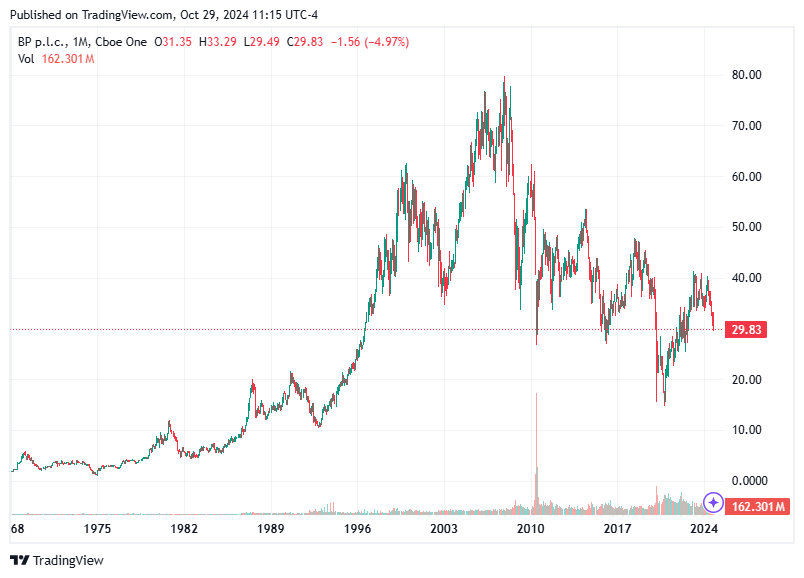British Oil Giant Reports Weakest Quarterly Earnings In Four Years
BP Reports Weakest Quarterly Earnings in Four Years Amid Lower Crude Prices.

Disclaimer: This article is intended for informational purposes only and should not be considered as financial advice. The views expressed are based on publicly available information and are subject to change without notice.
BP's recent quarterly earnings report has garnered attention as the company posted its weakest results in nearly four years. This downturn is primarily attributed to the decline in global crude oil prices, which have adversely impacted BP's financial performance.
BP's Quarterly Earnings at a Glance
For the third quarter of this year, BP reported an underlying replacement cost profit of $2.3 billion. While this figure surpassed analyst expectations of $2.1 billion, it marked a notable drop from the $3.3 billion profit recorded in the same period the previous year. The earnings also fell short of the $2.8 billion net profit from the preceding quarter. This decline highlights the persistent challenges BP faces in maintaining profitability amidst fluctuating oil prices.
The primary factor contributing to BP's earnings slump is the fall in global crude oil prices. Oil prices have been volatile, with Brent crude hovering around $71 per barrel, down from $75 earlier. This decline is influenced by many factors, including weak demand from China, geopolitical tensions, particularly in the Middle East, and the global economic outlook.
China, being the world's largest energy importer, plays a pivotal role in the demand dynamics of crude oil. The country's sluggish economic recovery and reduced industrial activity have dampened oil demand, exerting downward pressure on prices. Additionally, despite ongoing conflicts in the Middle East, such as tensions between Israel and Iran, oil prices have not surged as expected. This is partly due to Israel's tactical decision not to target Iranian oil infrastructure, thereby alleviating fears of supply disruptions.
BP's Response
In response to these challenges, BP's CEO, Murray Auchincloss, has outlined multiple initiatives aimed at stabilizing the company's financial health and reassuring shareholders. One key strategy is maintaining the pace of quarterly share buy-backs at $1.75 billion, even in the face of reduced profits. This move is intended to enhance shareholder value and signal confidence in the company's long-term viability.
Auchincloss has also emphasized a shift in focus from volume to value in BP's oil and gas production. This approach entails prioritizing high-value assets and projects that promise substantial returns, rather than merely increasing output. This strategy aligns with BP's broader vision of navigating the energy transition while continuing to invest in fossil fuels.
BP has announced plans to cut at least $2 billion in cash costs by 2026 relative to 2023 levels. This cost-cutting initiative is crucial for maintaining financial flexibility and enabling the company to invest in growth opportunities amid a challenging market environment. The ongoing energy transition presents both challenges and opportunities for BP. On one hand, the global shift towards renewable energy sources and carbon reduction targets necessitates significant adjustments in BP's business model. On the other hand, the transition opens up new avenues for investment and growth in areas such as wind, solar, and biofuels.
BP has been proactive in positioning itself as a leader in the energy transition. The company has made substantial investments in renewable energy projects and aims to leverage its expertise in the oil and gas sector to drive innovation and sustainability. However, this transition has not been without controversy. Auchincloss recently faced criticism from environmental groups for allegedly abandoning a target to reduce BP's oil and gas output by 25% by 2030.
Despite these challenges, BP remains committed to balancing its traditional fossil fuel operations with investments in clean energy. The company plans to update investors on its financial strategy and transition plans in February, which will provide further insights into its long-term vision.
Effects on the Energy Sector
BP's earnings report reflects broader trends and challenges within the global energy sector. The volatility in oil prices, driven by geopolitical tensions and economic uncertainty, highlights the importance of adaptability for energy companies. As the world gradually transitions towards cleaner energy sources, traditional oil and gas companies must adapt to evolving market dynamics and regulatory frameworks.
The energy transition also presents a complex landscape for investors. Companies like BP must strike a delicate balance between maintaining profitability in the short term and investing in sustainable, long-term growth. This requires careful consideration of capital allocation, risk management, and stakeholder engagement. The decline in BP's earnings highlights the interconnectedness of global markets. Fluctuations in oil demand and supply can have far-reaching effects, not only for energy companies but also for broader economic stability. Policymakers, industry leaders, and investors must collaborate to address these challenges and facilitate a smooth transition towards a more sustainable energy future.
BP's recent quarterly earnings report serves as a stark reminder of the challenges facing the oil and gas industry. The decline in crude oil prices, coupled with the complexities of the energy transition, demands foresight and adaptability. As BP navigates these turbulent waters, its commitment to shareholder value, cost efficiency, and sustainability will be critical determinants of its success.
Disclaimer: This article is intended for informational purposes only and should not be considered as financial advice. The views expressed are based on publicly available information and are subject to change without notice.
We are working endlessly to provide free insights on the stock market every day, and greatly appreciate those who are paid members supporting the development of the Stock Region mobile application. Stock Region offers daily stock and option signals, watchlists, earnings reports, technical and fundamental analysis reports, virtual meetings, learning opportunities, analyst upgrades and downgrades, catalyst reports, in-person events, and access to our private network of investors for paid members as an addition to being an early investor in Stock Region. We recommend all readers to urgently activate their membership before reaching full member capacity (500) to be eligible for the upcoming revenue distribution program. Memberships now available at https://stockregion.net


